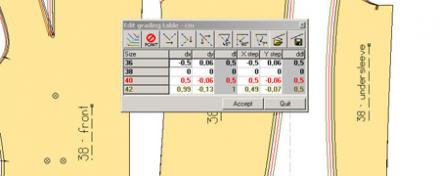 With our knowledge, based on long years experience, we can grade your pattern to specific size ranges from a base size sample pattern. We provide grading services from very simple to the most complicated sizes. We can generate an unlimited number of sizes from a base size pattern, each size will perfect match to your specifications. With your inputted digital pattern file, we can apply for you industry standard grading rules, follow your established grading system, or assist you in creating your own grading specifications. We will grade the patterns to your specifications, promptly and accurately.
With our knowledge, based on long years experience, we can grade your pattern to specific size ranges from a base size sample pattern. We provide grading services from very simple to the most complicated sizes. We can generate an unlimited number of sizes from a base size pattern, each size will perfect match to your specifications. With your inputted digital pattern file, we can apply for you industry standard grading rules, follow your established grading system, or assist you in creating your own grading specifications. We will grade the patterns to your specifications, promptly and accurately.
You can send us your basic model designed on solid pattern (cardboard, paper, etc.) or in electronic format and we can grade your model into the desired size on a given chart with measurement data, or we can assist you with standard size data.
The first step in any grading exercise is to accurately measure your base pattern. Sometimes we can find the key measurements you need (bust, waist, and hip) on the pattern envelope.
Grading From First Pattern
If you have a first pattern and needed more sizes, we will grade all the necessary sizes to your exact specifications, as numeric or alphabetic sizes. We could offer and our specifications in case you do not have yours. We guarantee industry standard. Developing new grade rules is possible too. All patterns and grades will be returned for approval before we make markers, if you need. Your grade rules can be saved into our database for your future use.
We Can Do For You:
- Grading patterns to all sizes.
- Take your finished pattern and develop smaller and larger sizes.
- Grade your patterns using your specific grade rules.
- Grade after we assist you in establishing specs for your product.
- Apparel grading.
- Pattern grading.
- Enlarging sizes.
- Decreasing sizes.
What is Pattern Grading?
Pattern grading is the process of creating a range of sizes for a single style. Pattern grading is the scaling of a pattern to a different size by incrementing important points of the pattern using an algorithm in the clothing industry.
The purpose of grading is to proportionally increase or decrease the size of a pattern, while maintaining shape, fit, balance, and scale of style details (dress, original design). To properly fit a pattern to a range of sizes, each pattern piece needed to be graded, or systematically increased or decreased.
Patterns initially are made in only one size. In order to produce clothing that fits various body types and sizes, the pattern pieces must be increased or decreased geometrically to create a complete range of sizes. The process of resizing the initial pattern is called “grading.” Each company determines its own grade specifications for each size, and size specifications vary slightly from manufacturer to manufacturer.
Grading is the method used to increase or decrease the sample size production pattern to make up a complete size range. For example, the sample size 10 patterns must be made larger to accommodate sizes 12, 14 and 16 and smaller for sizes 8 and 6. Each company sets predetermined grade specifications, or rules. For example, a missy manufacturer’s grade rules might call for increments of one and a half inches in width and a quarter inch in length for each size.
Today most manufacturers grade pattern on CAD systems. The pattern maker guides a cursor around the edges of the sample pattern on a digitized table. At each of the key points, he or she pushes a button to record a grade point. Each point is cross referenced by a grade-rule table stored in the computer, which enlarges or reduces the pattern automatically according to the predetermined direction.If the pattern was originally made by computer, data are already in the computer and can be enlarged or reduced automatically.
Pre-programmed grade rules for increase or decrease are automatically applied to the pieces of each grading location. Then the computer can print out the pattern in each new size. Manufacturers often use an out side service to make patterns, grade patterns, and make the marker
Although many small firms still use traditional grading methods, grading, like pattern making, is becoming increasingly computerized. Using a CAD system, the pattern can be resized according to a predetermined table of sizing increments (or “grade rules”). The computerized plotter can then print out the pattern in each size. Because the productivity gains are so great, small to medium-sized manufacturers are beginning to acquire their own CAD systems for grading.
Alternatively, they may use an outside grading service to perform this function.
